Noctua (meaning Little Owl) is a company that has built quite a reputation in recent years. This is due to recent hits such as their increasingly popular CPU heatsinks and later the illustrious NF-P12 120mm fan! Until Noctua came long, if one wished to cool a processor quietly, then traditionally they would have been pointed in the direction of Nexus or Yateloon! Noctua has built their business model on cooling computers quietly and some may say effectively.
The traditional colour; of the Noctua fans have been a subject of contention for some. One would even go so far as to say that the colour scheme has a similar aspect to Marmite (You love it or you hate it) However, Noctua products could also be considered expensive by some and indeed the Akasa Apache fan offers similar performance for less money. Can Noctua build upon the good will of the consumer with their latest incarnation? Let us read on and find out!
Specifications
The NF-P14 offers very similar specifications to the previous models; in the blade design, however there are a few major differences in the rest of the model. There is of course the 140mm fan blades, the reinforced motor drive and the circular fan housing.
|
140x140x25 mm | |
| Bearing | SSO-Bearing | |
| Blade Geometry | NF-P14 Blade Design with VCN | |
| Rotational Speed (+/- 10%) | 1200 RPM | |
| Airflow | 110,3 m³/h | |
| Static Pressure | 1,29 mm H2O | |
| MTBF | 150.000 h | |
| Scope of Delivery |
|
|
| Warranty | 6 years |
Product Images
The Noctua box design is of similar to that of previous incarnations, with a small window at the front of the box in order to give a hint on the product that has been purchased! It would have to be noted that the colour scheme of the box, matches that of the fan model itself; with the exception of the inner pages, of which are a medium-blue.
| Box Front | Box Rear |
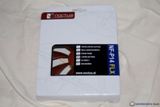 |
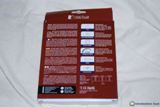 |
| Center Pages | Inner Carton |
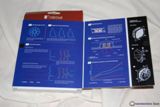 |
 |
The fan is supplied with a number of accesories, which include:
- Four Rubber AntiVibration Mounts
- Four self tapping screws
- Four 120mm to 140mm adaptors
- A number of speed limiting cables
| Accessories | The NF-P14 FLX |
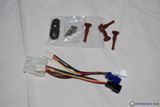 |
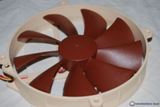 |
| Close-Up of The Motor |
The Reverse side of fan |
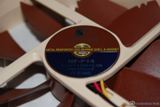 |
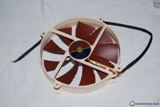 |
As listed in the specifications, the motor of the Noctua NF-P14 fan has been reinforced by metal supports; this would probably explain why Noctua are so confident that they give a six year warranty on this model. To demonstrate the purpose of the metal mounts in conjunction with the motor; a manufacturers diagram is listed below.
Just like the 120MM NF-P12 series model there are a series of notches placed on each fan blade in order to create maximum airflow, this is in addition to the angle of attack on the fan blades itsself.  According to Noctua’s website the staggered notches is used in order to further increase the static pressure of the fan-but without more noise. This is especially important in the ‘water-cooling’ field, where the fan has been mounted upon a radiator.
| Fan Blades | The Blade Notches |
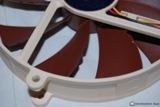 |
 |
| 120mm Mounts | Mountings Explained |
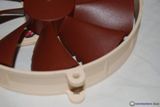 |
 |
As usual, and as with all of Noctua’s range of fans, the power lead has been braided to perfection. Strictly-speaking-though cosmetic it does help to give a nice final finish to the fan. Lastly and this has been mentioned before, the colour scheme of the fans is subject to taste. This reviewer does indeed like the colour scheme, though the blades should be two shades of red higher. The photographs in this review look as though the blades are red-; they are indeed a brown colour. The flash has helped to give them a shade of red, However as with anything of this nature, the colour scheme is subject to personal preferences.
Testing
Testing Methodology on a Water-Cooling Enviroment
Our testing regime has been; as usual vigorous, with the exact same testing equipment as if we were reviewing a radiator. A hardware Lian-Li sensor was placed before the fan and after the radiator. An inline sensor was used to monitor the fluid going into the CPU and another exiting. For the CPU temperature ‘REALTEMP 3.0′ was used.
It is at this time, it would be prudent to note that ambient air temperature through-out these tests were set at 21 degrees Celsius in a controlled environment. All idle temperatures were only taken after 1 hours of Prime95 use, and then left to cool down for a further thirty minutes. Full load temperatures were then taken after another hour of use.
It must be noted that sound tests were not recorded, as they would be subject to the volume control on your computer. However a written comparison to try and describe  how loud or quiet these fans are will be carried out later. All fans were ran at their MAXIMUM speed for an’ out of the box experience’ though it must be noted that the Noctua fan is actually 100rpm SLOWER than the compared fans.
Test bench specifications.
- ATI X1600 Video Card
- Corsair Dominator ram at 1866 3×1 Gigabyte
- Water Cool Heatkiller 30.0 (copper and with backing plate)
- LAING ddc Ultra pump
- BlackIce sr1 140mm Radiator
- Dismastech Benching Table
- DFI X58 UT T3EH8 Systemboard
- Intel COre i7 920 at stock voltage and speeds
If one wishes to compare all the average temperatures on idle and full load, then all results are very similar with Noctua actually being in last place. However if then the maximum temperatures are taken into account-then this tells a completely new story! On idle the Noctua NF-P14FLX simply storms ahead of the Scythe Kaze Maru and the Xigmatec.
It is to be noted that the Scythe Kaze Maru uses a similar concept to that of the Noctua NF-P14FLX, which is, using a 120mm mounting method!  Whilst the Scythe fan is being mentioned; the 120mm to 140mm adapters that were part of the Noctua box were also used on the Scythe, for a like for like test. With the aforementioned fans, there is an issue when both models are used in a radiator environment. Due to the nature of the circular housing the fans do NOT create an air-tight seal around the edges of the radiator. Indeed it leaves gaping gaps uncovered and airflow does not strike these areas.
It is fair to say if the same technology was used I.E blade design and motor but combined into a regular housing with native 140mm mountings-then BOTH fans would then perform better in this environment-due to air-tight seal being created. In all due fairness despite this major disadvantage, both the Noctua and the Scythe stormed head of the TRUE 140MM Xigmatec fan of which DOES create an air-tight seal. So a well-done is due to Noctua and the Scythe fans!
Testing in an Air Cooling Enviroment
Test setup
- MSI-P55-GDI Motherboard
- 4GB GSkill Reaper 2000mhz
- Core i7 860 (Stock)
- EVGA GTX260 SSC
- Noctua NH-U12P (provided by Noctua)
- Corsair HX620w (Main power)
- FSP 250w (Fan and probe power)
Summary and Conclusion
- Good Performance
- Hard Wearing
- Fantastic Warranty
- Compatible with 120mm Mountings
- Nice bundle of ‘Extras’
- Colour Scheme (Though subject to taste)
- Does not Create an air-tight seal on a radiator
- Could be deemed as expensive for some
- Performance is good but not much better than the competition

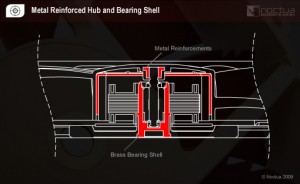
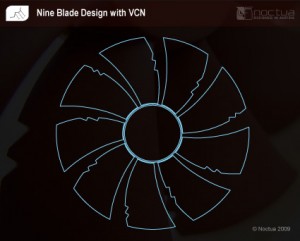

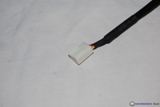
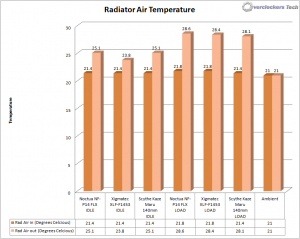








 Posted in
Posted in 

